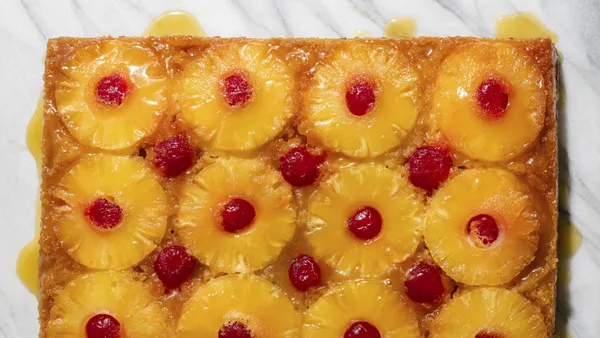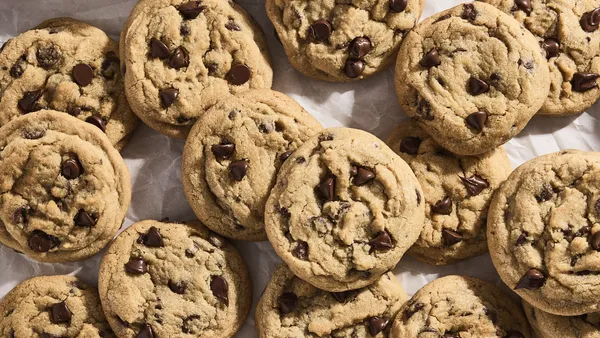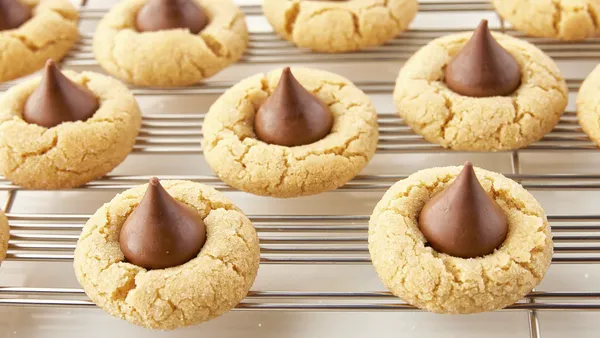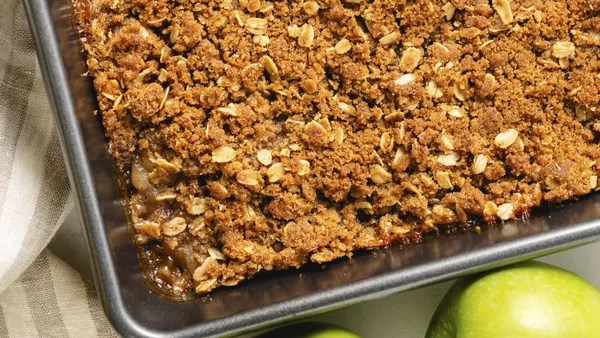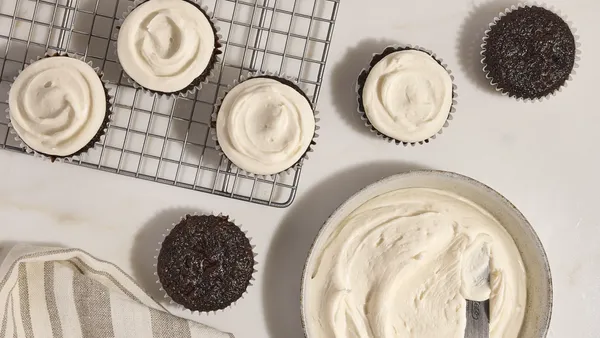How to Make Baked Pie Crust
The full steps on how to bake pie crust are down below, but here are a few things to watch out for.
After preheating your oven, thoroughly mix the flour and salt in a bowl, then add the shortening. You’ll want the dry ingredients to be fully combined before adding additional ingredients. Mix in the shortening with a pastry blender, or if you don’t have one, you can pull 2 table knives through the ingredients in opposite directions until it’s the size of small peas.
Now it’s time to sprinkle in cold water—one tablespoon at a time—until all the flour has some moisture, and the pastry almost pulls away from the side of the bowl.
Form the dough into a flattened ball, then wrap it in plastic wrap and let it sit in the fridge for about 45 minutes. This is where the dough will firm up, so that when it bakes, it gives you that perfectly flaky texture you’re after.
Then you just roll it out on a floured surface and bake it. Be sure to prick the bottom and side of the pastry with a fork to prevent bubbles from forming, then bake until it’s light brown—how long to bake a pie crust will vary by oven, but it’s usually about 8 to 10 minutes.
How to Roll out Pie Dough and Place in Dish
Lightly flour the rolling pin and the surface you’re rolling the pie crust on to prevent sticking, and add flour only as needed. Be sure to keep the dough level. It’s best to roll in several different directions, and then turn the dough in order to keep the circle a similar thickness.
How do you know when it’s the right size? You can check by flipping your pie plate upside-down on the dough circle. When your dough overlaps the pie plate by about 2 inches, you’ll know it’s ready.
Placing the crust into the pie plate can be tricky. But these tips will prove successful. To easily center the crust, first gently fold it into fourths. Then ease it into the pie plate, and carefully unfold, pressing firmly into the bottom and the sides. Trim the overhanging dough 1 inch from the rim of the pie plate, then wrap and press this excess dough around the rim.
How to Pre-Bake/Blind Bake Pie Crust
Blind baking a pie crust—also known as par-baking—is an essential step in making certain kinds of pies or quiches. If your pie filling is eggy or custard-like in texture, a blind baked pie crust recipe will partially firm up your pie crust so that the filling can cook properly. No-bake pies or pies that set quickly like pumpkin pie will also require a baked pie crust.
If you’re blind baking pie crust, just modify this recipe by reducing your oven heat to 425° and bake for about 15 minutes, or until the edges of the crust are golden and the bottom looks dry.
See More of Betty’s Easy Pie Recipes
This baked pie crust recipe is designed to work perfectly with any of the easy pie recipes from our kitchen. If you’re looking for inspiration, here are a few amazing ideas to try.
Tasty apple pie with a crisp, nutty topping? And it’s ready to bake in just a few simple steps? Yes, please! There’s a reason we call this Impossibly Easy French Apple Pie.
When you’re looking for an all-time favorite that always brings something delicious to the table, you can find it in this Decadent Pecan Pie.
The Classic Blueberry Pie is easier than you think, but still bursting with flavor. Unlike other fruit pies, blueberries don’t require fussy peeling or pitting, so prep is simple!
Just 10 minutes of prep time is all it takes to make this appropriately named Impossibly Easy Pumpkin PieImpossibly Easy Pumpkin Pie. Perfect for the holidays, or any time.
Frequently Asked Questions
Why Do I Have to Use Cold Water?
Flour is a very distinctive and versatile ingredient. When it comes to baking, every variable can affect the texture you get in the end. Put simply, the reason you want cold water in a baked pie crust recipe is to prevent the flour from combining too well with the other ingredients.
You want enough moisture to get the pie to combine smoothly, but if the water is warm, the flour will absorb the water much more quickly. And even worse, if the water is too hot, it can cause the fat of the butter or shortening to melt, and dissolve into the dough.
The magic of this baked pie crust recipe is in those perfectly formed pieces of shortening wrapped in flour. If they dissolve together and become too uniform, you won’t get that classic flaky pie crust texture you love.
Do I Need a Pastry Blender for This Recipe?
A pastry blender will make this baked pie crust recipe a whole lot easier, but if you don’t have one, there are several other things you can use instead.
If you use a food processor or blender, it’s recommended that you set it to the lowest setting and pulse it a few times, until it forms into small particles about the size of a pea. It’s essential you don’t over blend. That’s how you’ll ensure you get that perfect pie crust texture.
If you don’t have a food processor, no problem. You can use a pair of table knives, or a fork, or even your fingers to mix the pie dough. It may take a little extra time, but you can make it happen, equipment or no.
Can I Make This Pie Crust in Advance?
Baked pie crust is a perfect make-ahead recipe to help you cut down on time if you’re planning a big celebration. After you bake it, wrap tightly in plastic wrap and store in the fridge for a few days, or you can freeze for up to three months.
Depending on the kind of pie you’re making, you might not even need to thaw it. If you’re making a custard-based pie like a pumpkin pie, you can just pull it out of the freezer and pop it in the oven. For most other pies, however, you should let it come back to room temperature.
(function() {
document.addEventListener('DOMContentLoaded', function() {
var componentMetadata = JSON.parse('\x7b\x22componentName\x22\x3a\x22RecipeFAQ_2ee1ece6-a33c-4f37-aafb-6377bfa48ff1\x22,\x22deferOptions\x22\x3a\x7b\x22deferComponent\x22\x3afalse,\x22deferType\x22\x3a\x22None\x22,\x22deferId\x22\x3a\x22rcd3b8d4380954c339256238228e50ef9\x22,\x22deferredContainerId\x22\x3a\x22\x2fmain\x2frdpFAQ\x22,\x22deferredContainerView\x22\x3anull\x7d,\x22viewName\x22\x3a\x22RecipeFAQ\x22\x7d');
var configuration = {"title":"Baked Pie Crust","introduction":"\u003cp\u003eThe pie crust contains more than just delicious ingredients. It’s the gateway to a world of culinary memories that go back generations. So many classic dishes use a baked pie crust as their base. From fluffy, savory quiches to sweet, indulgent pies, it all starts with a great baked pie crust. For that perfectly flaky, made-from-scratch taste and texture, this baked pie crust recipe makes it easy to go from zero to delicious with minimal ingredients and just a few minutes of simple prep.\u003c/p\u003e\n\u003cp\u003eWhen you’ve got the time to put together a baked pie crust, it can make a huge difference in the finished product. And what better way to show off what you can do in the kitchen than with a homemade crust from scratch?\u003c/p\u003e\n\u003cp\u003eWhether you’re making something sweet, something savory, or somewhere in between, this baked pie crust recipe is designed to help you make it amazing with less time, less effort, and less hassle than you might expect! So let’s take a closer look at how to bake a pie crust!\u003c/p\u003e\n","servingSize":"1 Serving","image":{"small":{"media":"(min-width: 0px)","src":"https://mojo.generalmills.com/api/public/content/8-qoeRCvSPiRgsc7FdcVvw_webp_base.webp?v=9c2e79c6\u0026t=e724eca7b3c24a8aaa6e089ed9e611fd"},"medium":{"media":"(min-width: 500px)","src":"https://mojo.generalmills.com/api/public/content/8-qoeRCvSPiRgsc7FdcVvw_webp_base.webp?v=9c2e79c6\u0026t=191ddcab8d1c415fa10fa00a14351227"},"large":{"media":"(min-width: 767px)","src":"https://mojo.generalmills.com/api/public/content/8-qoeRCvSPiRgsc7FdcVvw_webp_base.webp?v=9c2e79c6\u0026t=191ddcab8d1c415fa10fa00a14351227"},"alt":"Baked Pie Crust"},"contributor":{"label":"By","name":"Betty Crocker Kitchens","profileUrl":"/about-us","displayDate":{"label":"Updated","date":"Nov 19, 2024"}},"ingredientGroups":[{"ingredients":[{"quantity":"1","description":"cup plus 1 tablespoon Gold Medal™ All Purpose Flour"},{"quantity":"1/2","description":"teaspoon salt"},{"quantity":"1/3","description":"cup shortening"},{"quantity":"3","description":"to 5 tablespoons ice-cold water"}]}],"steps":[{"description":"Heat oven to 475°F. Mix flour and salt in medium bowl. Cut in shortening, using pastry blender (or pulling 2 table knives through ingredients in opposite directions), until particles are size of small peas. Sprinkle with cold water, 1 tablespoon at a time, tossing with fork until all flour is moistened and pastry almost leaves side of bowl (1 to 2 teaspoons more water can be added if necessary). ","stepShotImageUrl":"//mojo.generalmills.com/api/public/content/LIzIPOzSQO21nWsBnSE11w_webp_base.webp?v=5d3dd6d6\u0026t=51a43a57af4046789e5a7f20567b1195"},{"description":" Gather pastry into a ball. Shape into flattened round on lightly floured surface. Wrap flattened round of pastry in plastic wrap and refrigerate about 45 minutes or until dough is firm and cold, yet pliable. This allows the shortening to become slightly firm, which helps make the baked pastry more flaky. If refrigerated longer, let pastry soften slightly before rolling. ","stepShotImageUrl":"//mojo.generalmills.com/api/public/content/FA162bQhTY-TAiSs-tAkTw_webp_base.webp?v=72681d4d\u0026t=51a43a57af4046789e5a7f20567b1195"},{"description":"Roll pastry, using floured rolling pin, into circle 2 inches larger than upside-down 9-inch glass pie plate. Fold pastry into fourths; place in pie plate. Unfold and ease into plate, pressing firmly against bottom and side. Trim overhanging edge of pastry 1 inch from rim of pie plate. Fold and roll pastry under, even with plate; flute as desired. Prick bottom and side of pastry thoroughly with fork. \n","stepShotImageUrl":"//mojo.generalmills.com/api/public/content/IHrxaJTUTiqQ5CJ4WiqKcA_webp_base.webp?v=58fe32e1\u0026t=51a43a57af4046789e5a7f20567b1195"},{"description":"Bake 8 to 10 minutes or until light brown; cool on wire rack."}],"tips":[{"title":"","description":"Learn how to make the perfect pie crust with this easy pie crust recipe. Quick, simple steps for a flaky, delicious crust every time!","category":"Rich Snippet","tipShots":[]},{"title":"","description":"For tender, flaky crusts, choose heat-resistant glass pie plate or aluminum pie pans with a dull finish. Shiny pie pans are not recommended because they reflect heat, causing a soggy bottom crust.","category":"Recipe/Ingredient Facts","tipShots":[]},{"title":"","description":"The best way to measure flour is to first stir the flour a bit before spooning into the measuring cup. Fill until heaping and then sweep the excess off the top with the flat edge of a butter knife.","category":"Presentation/Garnish","tipShots":[]},{"title":"","description":"Pricking the bottom and side of pastry thoroughly with a fork prevents crust from puffing while baking.","category":"Recipe/Ingredient Facts","tipShots":[]},{"title":"","description":"Overworking the pastry dough will make it tough—handle it as little as possible.","category":"Recipe/Ingredient Facts","tipShots":[]},{"title":"","description":" To flute pastry, place thumb and index finger about 1 inch apart on outside of raised edge. With other index finger, push pastry toward outside, continuing around edge, repeating motion, to form decorative edge.","category":"No Title","tipShots":[]},{"title":"","description":"Somewhere along the line, people got the idea that homemade pie crust is hard to make. But here’s the thing, this pie crust recipe is made with only four ingredients: flour, shortening, water and a sprinkle of salt. You can easily make it yourself, and it’s well worth the effort. Flaky, buttery and tender crust can be yours with minimum effort. Betty’s here to show you how it’s done — every detail you could ever need to know is here in this article about \u003ca href=\u0022https://www.bettycrocker.com/how-to/tipslibrary/baking-tips/how-to-make-pie-crust\u0022target=\u0022_blank\u0022\u003ehow to make pie crust\u003c/a\u003e — but honestly, you can skip the article and simply follow the recipe above. One quick note before you get started, pie crust is easier to make with a pastry blender — these inexpensive tools are available just about everywhere and usually cost less about $5 — so, if you don’t already own one, pick one up. Don’t have a pastry blender on hand? In a pinch you can use two knives or if you’ve got a food processor, you can use that too, but it’s certainly not necessary. The tips to making a perfect pie crust are as follows: Don’t overmix your pastry dough —you’ll want to blend the butter and flour into pea-sized crumbs. To get this gravel-like texture, use ice cold water. Next, you’ll chill your pastry mixture. When you’re ready to roll out the crust, flour your counter and your rolling pin to keep your pie crust from sticking or tearing. If you follow these simple tips, you’ll end up with a beautiful scratch-made pie crust, even on your first try! And once you master pie crust, you’ll want to explore all of Betty’s sweet \u003ca href=\u0022https://www.bettycrocker.com/recipes/dishes/pie-and-tart-recipes\u0022target=\u0022_blank\u0022\u003epie recipes\u003c/a\u003e. One final note, there’s no shame in using a refrigerated crust, we rely on \u003ca href=\u0022https://www.pillsbury.com/products/pie-crust/refrigerated-pie-crust\u0022target=\u0022_blank\u0022\u003ePillsbury’s delicious pie crusts\u003c/a\u003e too, but we also think making pie crust is a skill everyone can and should master, which is why we’ve been teaching people to make their own for nearly a century!","category":"Editorial","tipShots":[]},{"title":"","description":"Recipe meets Kitchen Tested criteria. Reviewed as part of SEO improvements Oct. 2019.","category":"Kitchen Tested","tipShots":[]}],"kitchenTips":[{"title":"","description":"For tender, flaky crusts, choose heat-resistant glass pie plate or aluminum pie pans with a dull finish. Shiny pie pans are not recommended because they reflect heat, causing a soggy bottom crust.","category":"Recipe/Ingredient Facts","tipShots":[]},{"title":"","description":"The best way to measure flour is to first stir the flour a bit before spooning into the measuring cup. Fill until heaping and then sweep the excess off the top with the flat edge of a butter knife.","category":"Presentation/Garnish","tipShots":[]},{"title":"","description":"Pricking the bottom and side of pastry thoroughly with a fork prevents crust from puffing while baking.","category":"Recipe/Ingredient Facts","tipShots":[]},{"title":"","description":"Overworking the pastry dough will make it tough—handle it as little as possible.","category":"Recipe/Ingredient Facts","tipShots":[]},{"title":"","description":" To flute pastry, place thumb and index finger about 1 inch apart on outside of raised edge. With other index finger, push pastry toward outside, continuing around edge, repeating motion, to form decorative edge.","category":"No Title","tipShots":[]}],"additionalContent":[{"title":"How to Make Baked Pie Crust","description":"\u003cp\u003eThe full steps on how to bake pie crust are down below, but here are a few things to watch out for.\u003c/p\u003e\n\u003cp\u003eAfter preheating your oven, thoroughly mix the flour and salt in a bowl, then add the shortening. You’ll want the dry ingredients to be fully combined before adding additional ingredients. Mix in the shortening with a pastry blender, or if you don’t have one, you can pull 2 table knives through the ingredients in opposite directions until it’s the size of small peas.\u003c/p\u003e\n\u003cp\u003eNow it’s time to sprinkle in cold water—one tablespoon at a time—until all the flour has some moisture, and the pastry almost pulls away from the side of the bowl.\u003c/p\u003e\n\u003cp\u003eForm the dough into a flattened ball, then wrap it in plastic wrap and let it sit in the fridge for about 45 minutes. This is where the dough will firm up, so that when it bakes, it gives you that perfectly flaky texture you’re after.\u003c/p\u003e\n\u003cp\u003eThen you just roll it out on a floured surface and bake it. Be sure to prick the bottom and side of the pastry with a fork to prevent bubbles from forming, then bake until it’s light brown—how long to bake a pie crust will vary by oven, but it’s usually about 8 to 10 minutes.\u003c/p\u003e\n","category":"SEO Content_1","tipShots":[]},{"title":"How to Roll out Pie Dough and Place in Dish","description":"\u003cp\u003eLightly flour the rolling pin and the surface you’re rolling the pie crust on to prevent sticking, and add flour only as needed. Be sure to keep the dough level. It’s best to roll in several different directions, and then turn the dough in order to keep the circle a similar thickness.\u003c/p\u003e\n\u003cp\u003eHow do you know when it’s the right size? You can check by flipping your pie plate upside-down on the dough circle. When your dough overlaps the pie plate by about 2 inches, you’ll know it’s ready.\u003c/p\u003e\n\u003cp\u003ePlacing the crust into the pie plate can be tricky. But these tips will prove successful. To easily center the crust, first gently fold it into fourths. Then ease it into the pie plate, and carefully unfold, pressing firmly into the bottom and the sides. Trim the overhanging dough 1 inch from the rim of the pie plate, then wrap and press this excess dough around the rim.\u003c/p\u003e\n","category":"SEO Content_2","tipShots":[]},{"title":"How to Pre-Bake/Blind Bake Pie Crust","description":"\u003cp\u003eBlind baking a pie crust—also known as par-baking—is an essential step in making certain kinds of pies or quiches. If your pie filling is eggy or custard-like in texture, a blind baked pie crust recipe will partially firm up your pie crust so that the filling can cook properly. No-bake pies or pies that set quickly like pumpkin pie will also require a baked pie crust.\u003c/p\u003e\n\u003cp\u003eIf you’re blind baking pie crust, just modify this recipe by reducing your oven heat to 425° and bake for about 15 minutes, or until the edges of the crust are golden and the bottom looks dry.\u003c/p\u003e","category":"SEO Content_3","tipShots":[]},{"title":"See More of Betty’s Easy Pie Recipes","description":"\u003cp\u003eThis baked pie crust recipe is designed to work perfectly with any of the easy pie recipes from our kitchen. If you’re looking for inspiration, here are a few amazing ideas to try.\u003c/p\u003e\n\u003cp\u003eTasty apple pie with a crisp, nutty topping? And it’s ready to bake in just a few simple steps? Yes, please! There’s a reason we call this \u003ca href=\u0022https://www.bettycrocker.com/recipes/impossibly-easy-french-apple-pie/7f79f7f1-cbf7-4866-86e2-0054e53d7f2f/\u0022\u003eImpossibly Easy French Apple Pie\u003c/a\u003e.\u003c/p\u003e\n\u003cp\u003eWhen you’re looking for an all-time favorite that always brings something delicious to the table, you can find it in this \u003ca href=\u0022https://www.bettycrocker.com/recipes/decadent-pecan-pie/ed23a937-97d2-4365-935c-46444a23c1e9/\u0022\u003eDecadent Pecan Pie\u003c/a\u003e.\u003c/p\u003e\n\u003cp\u003eThe \u003ca href=\u0022https://www.bettycrocker.com/recipes/classic-blueberry-pie/78e913d6-7e53-4ee3-bec5-ca38083b70b0/\u0022\u003eClassic Blueberry Pie\u003c/a\u003e is easier than you think, but still bursting with flavor. Unlike other fruit pies, blueberries don’t require fussy peeling or pitting, so prep is simple!\u003c/p\u003e\n\u003cp\u003eJust 10 minutes of prep time is all it takes to make this appropriately named \u003ca href=\u0022https://www.bettycrocker.com/recipes/impossibly-easy-pumpkin-pie/c0eab3d9-06a3-4829-9125-7581f1d96315/\u0022\u003eImpossibly Easy Pumpkin Pie\u003c/a\u003eImpossibly Easy Pumpkin Pie. Perfect for the holidays, or any time. \u003c/p\u003e","category":"SEO Content_4","tipShots":[]}],"faq":[{"title":"Why Do I Have to Use Cold Water?","description":"\u003cp\u003eFlour is a very distinctive and versatile ingredient. When it comes to baking, every variable can affect the texture you get in the end. Put simply, the reason you want cold water in a baked pie crust recipe is to prevent the flour from combining too well with the other ingredients.\u003c/p\u003e\n\u003cp\u003eYou want enough moisture to get the pie to combine smoothly, but if the water is warm, the flour will absorb the water much more quickly. And even worse, if the water is too hot, it can cause the fat of the butter or shortening to melt, and dissolve into the dough.\u003c/p\u003e\n\u003cp\u003eThe magic of this baked pie crust recipe is in those perfectly formed pieces of shortening wrapped in flour. If they dissolve together and become too uniform, you won’t get that classic flaky pie crust texture you love.\u003c/p\u003e","category":"FAQ_1","tipShots":[]},{"title":"Do I Need a Pastry Blender for This Recipe?","description":"\u003cp\u003eA pastry blender will make this baked pie crust recipe a whole lot easier, but if you don’t have one, there are several other things you can use instead.\u003c/p\u003e\n\u003cp\u003eIf you use a food processor or blender, it’s recommended that you set it to the lowest setting and pulse it a few times, until it forms into small particles about the size of a pea. It’s essential you don’t over blend. That’s how you’ll ensure you get that perfect pie crust texture.\u003c/p\u003e\n\u003cp\u003eIf you don’t have a food processor, no problem. You can use a pair of table knives, or a fork, or even your fingers to mix the pie dough. It may take a little extra time, but you can make it happen, equipment or no.\u003c/p\u003e\n","category":"FAQ_2","tipShots":[]},{"title":"Can I Make This Pie Crust in Advance?","description":"\u003cp\u003eBaked pie crust is a perfect make-ahead recipe to help you cut down on time if you’re planning a big celebration. After you bake it, wrap tightly in plastic wrap and store in the fridge for a few days, or you can freeze for up to three months.\u003c/p\u003e\n\u003cp\u003eDepending on the kind of pie you’re making, you might not even need to thaw it. If you’re making a custard-based pie like a pumpkin pie, you can just pull it out of the freezer and pop it in the oven. For most other pies, however, you should let it come back to room temperature.\u003c/p\u003e\n","category":"FAQ_3","tipShots":[]}],"tipCategories":[{"categoryName":"Editorial","heading":"More About This Recipe","cssClass":"recipePartStory","expandOnInit":false,"expandText":"More +","collapseText":"Less -","expandEventName":"","collapseEventName":"","image":"","tips":[{"title":"","description":"Somewhere along the line, people got the idea that homemade pie crust is hard to make. But here’s the thing, this pie crust recipe is made with only four ingredients: flour, shortening, water and a sprinkle of salt. You can easily make it yourself, and it’s well worth the effort. Flaky, buttery and tender crust can be yours with minimum effort. Betty’s here to show you how it’s done — every detail you could ever need to know is here in this article about \u003ca href=\u0022https://www.bettycrocker.com/how-to/tipslibrary/baking-tips/how-to-make-pie-crust\u0022target=\u0022_blank\u0022\u003ehow to make pie crust\u003c/a\u003e — but honestly, you can skip the article and simply follow the recipe above. One quick note before you get started, pie crust is easier to make with a pastry blender — these inexpensive tools are available just about everywhere and usually cost less about $5 — so, if you don’t already own one, pick one up. Don’t have a pastry blender on hand? In a pinch you can use two knives or if you’ve got a food processor, you can use that too, but it’s certainly not necessary. The tips to making a perfect pie crust are as follows: Don’t overmix your pastry dough —you’ll want to blend the butter and flour into pea-sized crumbs. To get this gravel-like texture, use ice cold water. Next, you’ll chill your pastry mixture. When you’re ready to roll out the crust, flour your counter and your rolling pin to keep your pie crust from sticking or tearing. If you follow these simple tips, you’ll end up with a beautiful scratch-made pie crust, even on your first try! And once you master pie crust, you’ll want to explore all of Betty’s sweet \u003ca href=\u0022https://www.bettycrocker.com/recipes/dishes/pie-and-tart-recipes\u0022target=\u0022_blank\u0022\u003epie recipes\u003c/a\u003e. One final note, there’s no shame in using a refrigerated crust, we rely on \u003ca href=\u0022https://www.pillsbury.com/products/pie-crust/refrigerated-pie-crust\u0022target=\u0022_blank\u0022\u003ePillsbury’s delicious pie crusts\u003c/a\u003e too, but we also think making pie crust is a skill everyone can and should master, which is why we’ve been teaching people to make their own for nearly a century!","category":"Editorial","tipShots":[]}],"isExpandable":false},{"categoryName":"Kitchen Tested","heading":"More About This Recipe","cssClass":"recipePartStory","expandOnInit":false,"expandText":"More +","collapseText":"Less -","expandEventName":"","collapseEventName":"","image":"","tips":[{"title":"","description":"Recipe meets Kitchen Tested criteria. Reviewed as part of SEO improvements Oct. 2019.","category":"Kitchen Tested","tipShots":[]}],"isExpandable":false},{"categoryName":"Rich Snippet","heading":"","cssClass":"recipePartMethodNote","expandOnInit":false,"expandText":"More +","collapseText":"Less -","expandEventName":"","collapseEventName":"","image":"","tips":[{"title":"","description":"Learn how to make the perfect pie crust with this easy pie crust recipe. Quick, simple steps for a flaky, delicious crust every time!","category":"Rich Snippet","tipShots":[]}],"isExpandable":false}],"nutritionInfo":{"configuration":{"showAsTable":false,"noNutritionInformationAvailableMessage":"Nutrition Facts are not available for this recipe","poweredByText":"\u003cp\u003eNutrition information for this recipe is estimated using a leading nutrition calculation application, but is an estimate only. Actual nutrition values will vary based on the exact ingredients or brands you may use.\u003c/p\u003e\n\u003ca href=\u0022http://developer.edamam.com\u0022\u003ePowered By \u003cimg src=\u0022-/media/05422024943D4056883B09BBC2576F20.ashx\u0022 alt=\u0022Edamam\u0022 /\u003e\u003c/a\u003e","nutritionChartTitle":"Nutrition Facts","nutritionInformationLabel":"Nutrition","servingSizeText":"Serving Size:","dailyValuesDisclaimer":"*Percent Daily Values are based on a 2,000 calorie diet.","percentDailyValueText":"% Daily Value","percentDailyValueFooterTitleText":"% Daily Value*:","exchangeInformationTitleText":"Exchanges:","nutritionFactsExpandText":"More Nutrition","nutritionFactsCollapseText":"Less Nutrition"},"servingSize":"1 Serving","exchangeInfo":"Free","showPoweredBy":false,"showRecipeTotalTime":true,"showRecipePrepTime":true,"showCarbohydrateChoices":false},"trademarks":[],"labels":{"ingredientsHeader":"Ingredients","stepsHeader":"Instructions","stepsImageHideText":"Hide Images","stepsImageShowText":"Show Images","stepNumberText":"Step","faqHeader":"Frequently Asked Questions","tipsHeader":"Recipe Tips","tipItemHeadingFormat":"tip {0}","postedBy":"By","copyright":"© {yyyy} ®/TM General Mills All Rights Reserved","showDrawerText":"Show ","hideDrawerText":"Hide","expandDescriptionText":"More +","collapseDescriptionText":"Less -","ariaLiveLabelFormat":"Showing {0} through {1} of {2}","scrollLeftButtonLabel":"Scroll Left","scrollRightButtonLabel":"Scroll Right","includeScrollIndicator":true},"primaryAttributes":[{"label":"Prep Time","values":[{"text":"25","label":"min"}]},{"label":"Total","values":[{"text":"1","label":"hr"},{"text":"15","label":"min"}]},{"label":"Servings","values":[{"text":"8"}]},{"label":"Ingredients","values":[{"text":"4"}]}],"secondaryAttributes":[],"badges":[{"badgeType":3,"badgeText":"","label":"kitchen tested","imageUrl":"/-/media/GMI/Core-Sites/BC/Images/Shared/RecipeParts/KitchenTested_BC1_new.jpg?sc_lang=en","linkUrl":"/about-us/kitchen-tested","metaDataTags":[],"showMemberInfo":false,"matchedMetadataId":"00000000-0000-0000-0000-000000000000"},{"badgeType":2,"badgeText":"Gold Medal Flour","label":"Make With","imageUrl":"/-/media/GMI/Core-Sites/BC/Images/Shared/RecipeParts/make-with/Package_GoldMedalv3.png?sc_lang=en","metaDataTags":["9223a3ed-9c14-580f-b9e7-f31f0ba02c9e"],"showMemberInfo":false,"matchedMetadataId":"9223a3ed-9c14-580f-b9e7-f31f0ba02c9e"}],"backgroundImageUrl":"/-/media/GMI/Core-Sites/BC/Images/Shared/RecipeParts/img-bc-rdp-heroDotPattern.png?sc_lang=en","breadcrumbs":{"links":[{"url":"/","label":"Home"},{"url":"/recipes","label":"Recipes"}],"currentPageName":"Baked Pie Crust"}};
var moduleName = 'recipeFaq';
var isVueModule = true;
GeneralMills.PandoSites.RegisterControlInstance(moduleName, configuration, componentMetadata, isVueModule)
});
})();
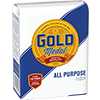
![]()
![]()
![]()





